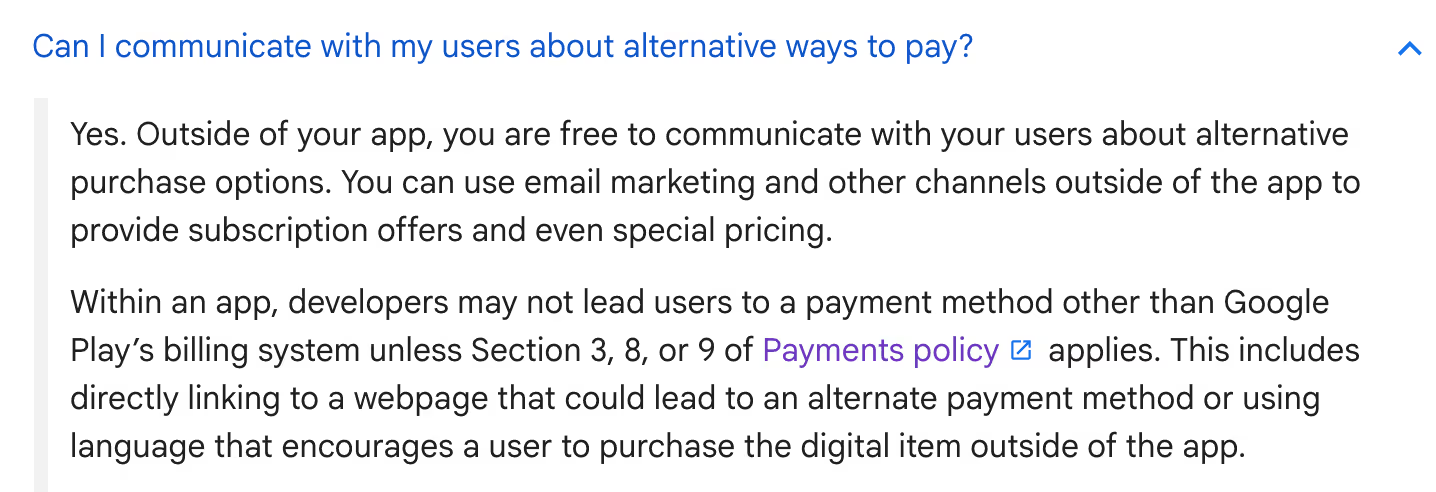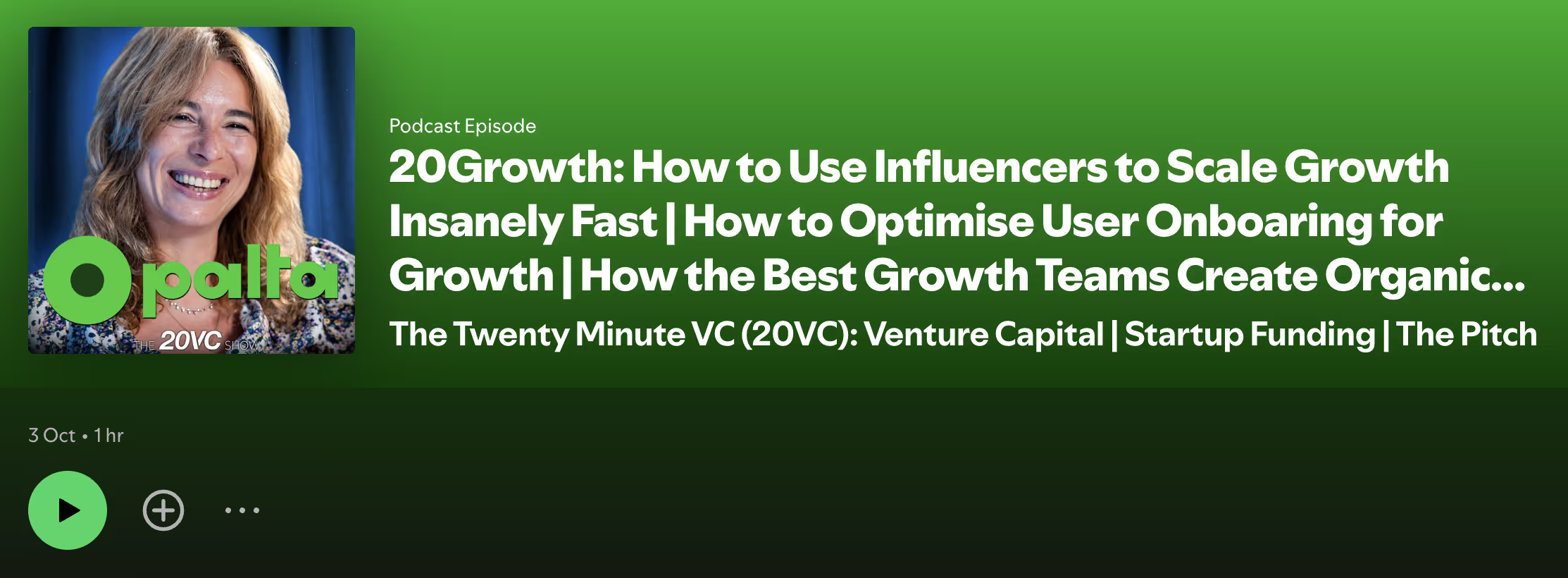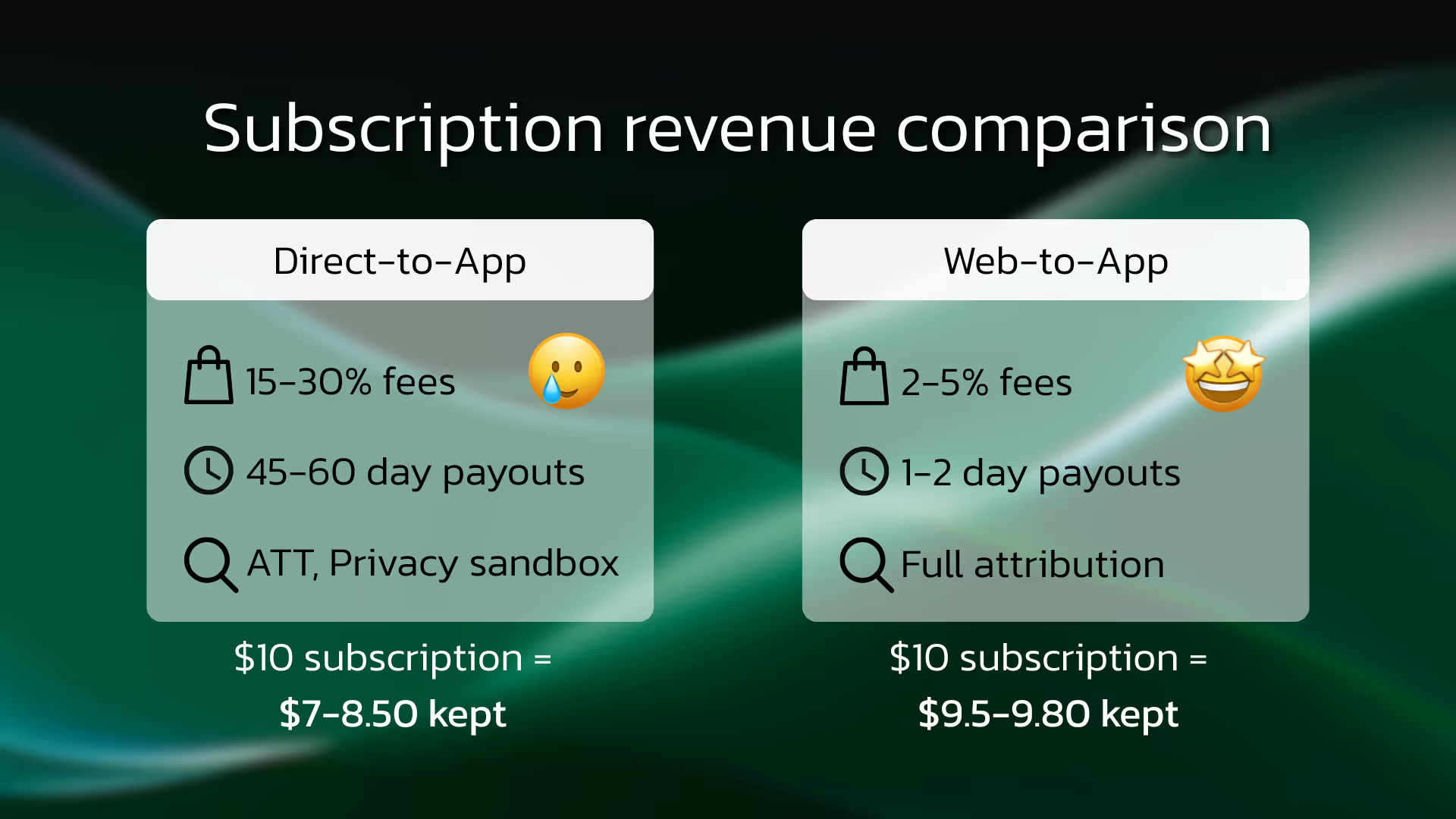Are Web2App funnels allowed? A complete guide to Apple App Store and Google Play compliance


If you're reading this, you've probably discovered web2app funnels, the strategy where users complete a quiz and purchase a subscription on your website before downloading your app. You're worried that bypassing the 15-30% app store commission might violate Apple App Store guidelines or Google Play policy.
This concern is understandable but misplaced. Let's examine what app store policies actually regulate, what they prohibit, and why web2app funnels fall completely outside their jurisdiction.
Understanding what app stores actually regulate
The key to understanding web2app funnel compliance lies in a simple question: what do app stores have authority over?
Apple and Google's policies regulate transactions that occur after someone has downloaded an app from their stores. When a user downloads your app, they become an "app user" with a relationship to that platform. The platform expects to facilitate commerce for digital goods sold within that relationship.
However, when a payment relationship is established on your website before any app is downloaded, no app store relationship exists yet. App stores have no jurisdiction over your website, your marketing funnels, or your customer acquisition. They can only regulate what happens inside apps distributed through their platforms.
- ✅ Outside app store jurisdiction: User sees ad → lands on website → completes quiz → pays on web → downloads app → accesses content
- ⚠️ Inside app store jurisdiction: User downloads app → opens as "app user" → app redirects to payment → user pays → returns to app
The difference is whether someone is already an "app user" when commerce occurs. Web2app funnels establish the customer relationship before any app store involvement.
What do Apple and Google policies actually prohibit?
Let's look at what Apple's App Store Review Guidelines and Google's Payments Policy actually prohibit:
Apple prohibits: Apps from using payment mechanisms other than in-app purchase for digital content that is consumed within the app. (Section 3.1.1)

Google prohibits: Apps distributed through Play from accepting payment for in-app features, functionality, or digital content without using Google Play's billing system. (Payments Policy)

What Google explicitly allows: "Outside of your app, you are free to communicate with your users about alternative purchase options. You can use email marketing and other channels outside of the app to provide subscription offers and even special pricing." (Payments Policy FAQ)

These policies regulate in-app commerce after download. Customer acquisition, marketing funnels, and web-based sales that occur before app store interaction fall outside this scope.
Real companies using web2app funnels without compliance issues
The strongest evidence for web2app legitimacy comes from hundreds of successful companies using this model without any app store enforcement actions:
Noom, the weight loss and wellness app, has operated a web-first payment funnel since 2016. That's over eight years without a single compliance issue. Noom's approach includes comprehensive web quizzes with over 25 post-purchase screens, dynamic branching based on user inputs, and multiple one-click upsells, all before users ever download the app.
Netflix and Spotify removed in-app purchase options from their iOS apps in 2018, requiring all new subscriptions to happen on their websites. Both companies continue to operate successfully on the App Store without any enforcement actions.
Headway, the book summary app with over 18 million downloads, implemented web subscriptions to diversify revenue streams. The company reports that web subscribers show higher retention, higher rebill rates, cancel less frequently, and are easier to re-engage than in-app subscribers.
BetterMe runs multiple web quiz funnels tailored to different audience segments (fitness, pilates, mental health, relationships), all directing to app downloads after payment. The company consistently ranks among the most downloaded wellness apps without any app store compliance issues.
Codeway, an AI and mobile technology company with over 300 million global users across 60+ products, recovered $500,000 in failed payments after implementing web-based subscriptions. The company achieved a 36% recovery rate on previously failed payments by using web payment infrastructure that provides more control over billing and retention flows than app store systems allow.
SaaS companies like Slack, Asana, and Notion have always operated with web-first signup flows where users create accounts on websites and then download companion apps. These publicly traded companies demonstrate that web2app is the standard operating model for enterprise and productivity applications.
At web2wave, we host over 7,300 quiz funnels and 6,000 paywalls across dozens of mobile apps. We see the compliance reality firsthand every day. To date, we have not seen a single app removed or flagged for compliance issues related to web2app funnels.
Live web2app quiz funnels you can explore
Want to see web2app funnels in action? Here are real quiz funnels from apps currently operating on the App Store and Google Play:
- Nibble
- Noom
- Flo (mobile browser)
- Simple
- Unimeal
- BetterMe fasting
- BetterMe pilates
- Headway
- Coursiv
- Nebula
- Blinkist
- Promova
- Liven
- Yoga go
- Muscle Booster
The reality: billion-dollar companies generate massive revenue through web2app
While some developers worry about theoretical compliance issues, major companies are building significant portions of their revenue on web2app funnels.

In an October 3, 2025 podcast interview (at the 00:23:30 mark), Ketty Slonimsky, Chief Growth Officer at Palta (the company behind Flo Health), revealed that Flo generates 50% of its revenue through web onboardings (web2app funnels). Across Palta's portfolio, 80% of new subscribers come through web rather than direct app downloads.
Ketty explains the strategy:
With free trials, you bring free trialists, which is a very weak signal. You want to bring payers, people who have high willingness to pay, and this is how you want to optimize your algorithms... We do web onboardings. 80% will be coming through web in all our companies apart from Flo, where it's split 50/50... We almost don't do free trial, we do intro-pricing which is different.
With 77 million monthly active users, Flo has built a proven web2app business model generating hundreds of millions in revenue.
You have a choice: You can worry about prohibitions that don't exist in any official policy, or you can follow the proven playbook of companies making billions in revenue through web2app funnels.
The economics: why web2app delivers superior results
Beyond compliance clarity, web2app funnels offer compelling economic advantages:
Dramatically lower payment processing fees

App stores charge 15-30% commissions on in-app purchases, while web payment processors charge 2-5%. For a $10 monthly subscription, this means keeping $9.40-$9.80 with web payments versus $7.00-$8.50 with in-app purchases. That's a 34-40% increase in revenue per subscriber.
Superior attribution and optimization
Web2app funnels provide full visibility into the user journey through standard web analytics. You can track every quiz question answered, every abandonment point, every pricing tier tested, and every conversion source with precise attribution. This data enables optimization impossible with app-only flows subject to iOS 14.5 App Tracking Transparency and Google's Privacy Sandbox restrictions.
Faster experimentation cycles
Changes to web funnels deploy instantly, while app updates require review processes taking days to weeks. You can A/B test pricing, messaging, quiz flows, and checkout experiences continuously without submitting app updates.
Better cash flow
App store payments are remitted 45-60 days after transaction, while web payment processors typically transfer funds in 1-2 business days. This dramatically improves cash flow, especially for growing companies that need capital to fund user acquisition.
This shift is gaining significant momentum. At the App Promotion Summit NYC 2025, Paddle CMO Andrew Davies revealed that consumer subscription apps now account for roughly a third of Paddle's transaction volume, up from "very little" two years ago, representing Paddle's fastest-growing segment.
Davies noted that the primary driver isn't just avoiding Apple's 30% fee:
"Frankly, it has not been one of the biggest drivers in many of the businesses that we serve."
Instead, companies prioritize improved cash flows, better customer data, and the ability to experiment rapidly with conversion funnels. Working capital acceleration from quarterly cycles to weekly or monthly enables fast-growing apps to scale without external financing.
Full customer relationship control
You can offer pause subscriptions, downgrade options, upsells, win-back campaigns, personalized cancellation flows, and flexible billing cycles. App store subscriptions provide limited flexibility. Users cancel through iOS settings, giving you no opportunity to address their concerns.
These advantages explain the rapid year-over-year growth in web-to-app spending, with industry analysis showing continued acceleration in adoption.
How to implement web2app funnels
Successfully implementing a web2app funnel requires understanding the user journey, building an effective quiz experience, and choosing the right payment infrastructure.
Building your quiz funnel
The quiz is the foundation of your web2app funnel. It personalizes the experience, builds engagement, and significantly increases conversion rates compared to direct app store listings.

web2wave is a no-code tool to build high-converting quiz funnels specifically designed for mobile app customer acquisition. Our platform includes:
- Quiz builder and templates for different verticals (fitness, wellness, productivity, education)
- Dynamic branching logic based on user responses
- Paywall builder with integrated payment systems
- Built-in A/B testing for continuous optimization
- Deep link integration for seamless app handoff
With web2wave, you can launch a complete web2app funnel without writing code or hiring developers.
The typical web2app user journey

User clicks ad → lands on website → completes quiz (15-50 questions) → sees personalized results → encounters paywall → completes web checkout → receives confirmation with app store link → downloads app → accesses purchased content immediately.
Choosing payment processors
Use Stripe, PayPal, Paddle, or similar web payment processors. Paddle, a merchant-of-record platform, offers specialized web2app payment solutions specifically designed for this model.
For apps that want backup payment options, web2wave integrates with Primer, allowing you to connect multiple payment providers. This ensures if one provider has issues, another automatically takes over, maximizing payment success rates. web2wave handles all subscription management, trials, and billing flows while Primer provides the payment reliability layer.
These web-based payment solutions give you control over the customer experience, faster payouts (1-2 days versus 45-60 days for app stores), and significantly lower fees.
Using deferred deep links for seamless transition
The key to connecting your web purchase to app access is deferred deep linking. Unlike regular deep links that only work if the app is already installed, deferred deep links work across the entire install journey.
Here's how it works:
- User completes checkout on your web funnel
- They receive a deferred deep link (via MMP like AppsFlyer, Adjust, or Branch)
- User clicks the link and is directed to App Store/Google Play
- After installing and opening the app for the first time, the MMP automatically passes the user_id and email to your app
- Your app uses this data to identify the user in your billing system (RevenueCat, Adapty, Qonversion) or directly via web2wave's API
- User immediately sees their purchased content without re-entering credentials
web2wave integrates with all major MMPs and provides the deferred deep link infrastructure out of the box. This creates a completely seamless experience where users feel like the web purchase and app access are one continuous journey, even though an app installation happened in between.
Addressing common concerns
"But isn't Apple strict about in-app purchases?"
Yes, Apple is strict about in-app purchases for app users. But web2app funnels establish payment relationships before someone becomes an app user. Apple's policies regulate what happens inside apps, not what happens on your website before anyone downloads your app.
"Will this model remain viable long-term?"
App stores have no authority over customer acquisition that happens on your website before any app download. They can only regulate what happens within their ecosystem, not independent web marketing. That's why companies like Flo have operated web2app funnels for years generating 50% of their revenue without issues. The regulatory trend worldwide is moving toward more payment flexibility, not less (EU Digital Markets Act, antitrust rulings, etc.).
"Won't I lose conversions requiring users to go to my website first?"
Data shows the opposite. Web2app funnels with optimized quiz experiences often convert better than app store listings because they provide personalized onboarding, social proof, and clear value propositions before asking for payment.
The future of mobile app monetization
Web2app funnels represent the strategic future of mobile app monetization. The evidence is overwhelming:
✅ App store policies don't regulate pre-download customer acquisition
✅ Hundreds of major companies use web2app successfully, some for 8+ years
✅ Billion-dollar companies generate 50-80% of revenue through web2app
✅ 7,300+ quiz funnels operate on web2wave without compliance issues
✅ Economic benefits provide 34-40% higher revenue per subscriber
✅ Zero documented cases of properly implemented web2app funnels resulting in app removals
The concern about app store violations stems from confusion about what app stores actually regulate. They regulate in-app commerce. They don't regulate your website, your marketing, or how you acquire customers before they ever interact with an app store.
Ready to implement web2app funnels?
web2wave provides the tools and templates you need to build high-converting web2app quiz funnels. Our platform is designed specifically for mobile app developers who want to:
- Reduce payment processing fees from 15-30% to 2-5%
- Gain full attribution visibility despite iOS 14.5 privacy changes
- Deploy and test funnel variations instantly without app updates
- Maintain complete control over customer relationships and retention
- Scale user acquisition with better unit economics
Every web2wave template follows best practices that thousands of successful apps use. You can build and launch your web2app funnel in days, not months, and start capturing the economic advantages that have driven 50% year-over-year growth in web-to-app spending.
Try web2wave for free or schedule a demo to see how web2app funnels can work for your app.
Key documentation for deeper reading:
- Apple App Store Review Guidelines, Section 3.1 - What Apple actually prohibits
- Google Play Payments Policy - What Google actually prohibits
- Paddle's web2app resources - Payment infrastructure guidance
- Palta CGO on web2app strategy - Real revenue data from 77M MAU app
Disclaimer: This article provides general information about app store policies based on official documentation. While we've extensively researched compliance requirements and operate thousands of web2app funnels without issues, you should consult with legal counsel if you have specific concerns about your app's implementation.



.png)

